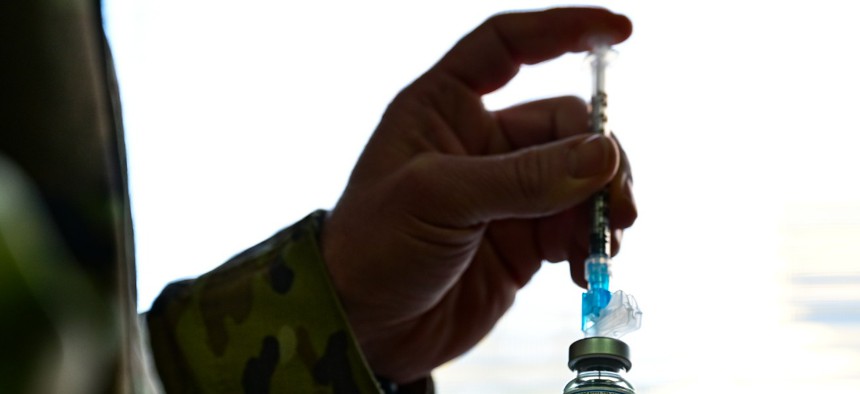
A service member prepares a COVID-19 vaccination dose on Feb. 4, 2021. Joshua J. Seybert / U.S. Air Force
One-Third of US Troops Are Refusing the COVID Vaccine. History May Help Explain Why
After botching anthrax shots decades ago, the Pentagon’s hands are tied. Only the president can order troops to take new vaccines.
U.S. troops are required to take many vaccinations before they enlist or deploy abroad, but the COVID-19 shot is still not among them. The terms of an “emergency use authorization” — the type of federal approval that governs the COVID-19 vaccines presently being distributed in the United States — prevent the Defense Department from requiring its administration. But the lack of a mandate was a topic of concern in Congress on Wednesday, where members heard from senior military officials that around one-third of military personnel offered the vaccine have refused it. Changing that trend may require a direct order from the new commander in chief, President Joe Biden, and the reason has little to do with anti-vaxxer conspiracies.
Only about two-thirds of troops offered the vaccine have taken it, said Air Force Maj. Gen. Jeff Taliaferro, vice director of operations at the Joint Chiefs of Staff, in testimony before the House Armed Services Committee. Air Force Maj. Gen. Steven Nordhaus, director of operations at the National Guard Bureau said the Guard is seeing similar rates. "Our experience mirrors the preliminary data that we're seeing in other communities," added Joint Staff Surgeon Brig. Gen. Paul Friedrichs.
About 359,000 troops have received their first vaccine dose; about 147,000 of those have received a second dose, said Robert Salesses, acting assistant defense secretary for homeland defense and global security.
Defense officials aren’t tracking why so many troops are turning down the vaccine.
“We don’t have a system in place across the services to specifically track data for those individuals who for whatever reason are declining or deferring the vaccine,” Pentagon spokesman John Kirby said at a briefing on Wednesday.
“Nobody is hiding data,” Kirby said when asked about the HASC testimony. “There’d be no reason for us to hide data when we can tell you exactly how many people are getting the vaccines. If there’s something more that was testified today, I promise I will get it to you, but nobody is trying to hide anything here.”
The hesitation by some personnel may have deeper roots than anti-vaxxer sentiments. It wasn’t all that long ago that the department required troops to take a vaccine that had far worse side effects than had previously been reported or tested.
During the Gulf War, the Defense Department asked for and the Federal Drug Administration established a special rule for military personnel that allowed command leadership to throw “informed consent” out the window for investigational new drugs, or IND, vaccines. The rule was meant to protect service members from “weaponized biological or chemical agents.”
More than 300,000 doses of the IND vaccine Anthrax Vaccine Absorbed (AVA) were distributed during Operation Desert Storm, probably to more than 150,000 service members. Years later, in 1997, Defense Secretary William Cohen launched the Anthrax Vaccine Immunization Program, or AVIP, in response to concerns about new biological weaponry. That program had 522,529 service members vaccinated with 2,098,544 doses of AVA by November 2001.
Many of these troops began reporting medically unexplained symptoms. A 2002 Government Accountability Office investigation showed that 85 percent of those who received the anthrax vaccine experienced adverse affects — more than double the rate that the vaccine manufacturer claimed.
Today, a version of the anthrax vaccine that has faced decades of additional research is required for military personnel in certain occupational specialities. But the FDA’s special rule for the blanket waiving of informed consent has long been adjusted. Today, only the president can authorize it and under very specific circumstances, a power reaffirmed in the 1999 Defense Authorization Act.
The Defense Department continues to face legal challenges from service members with medical conditions they believe are linked to the anthrax vaccine while carefully navigating the COVID-19 vaccines’ distribution to troops.
“It’s under an emergency use authorization,” Kirby said Wednesday. “It hasn’t achieved final FDA approval. So there’s a real limit, legally, on making it mandatory for troops and their families.”
Instead, Pentagon leaders seemingly are trying to lead by example. Defense Secretary Lloyd Austin was among those who had been vaccinated against COVID-19. Kirby added that he has also received his first shot.
“The secretary’s concern is primarily for the health and safety of the force. He’s taken the vaccine. He did that after talking to his doctor and determining that was the right choice for him,” Kirby said. “But he recognizes that these are individual decisions and individuals need to have these conversations with their doctors to determine if it’s the right thing for them…. Everybody is different.”
As of Wednesday, the Pentagon reported 237,561 confirmed cases of COVID-19 across the force, of which 152,905 are military personnel. The pandemic has resulted in 281 Defense Department-affiliated fatalities.
Correction: An earlier version misattributed statements about Defense Department vaccination rates given by Maj. Gen. Jeff Taliaferro and Maj. Gen. Steven Nordhaus in their Feb. 17 House testimony.







